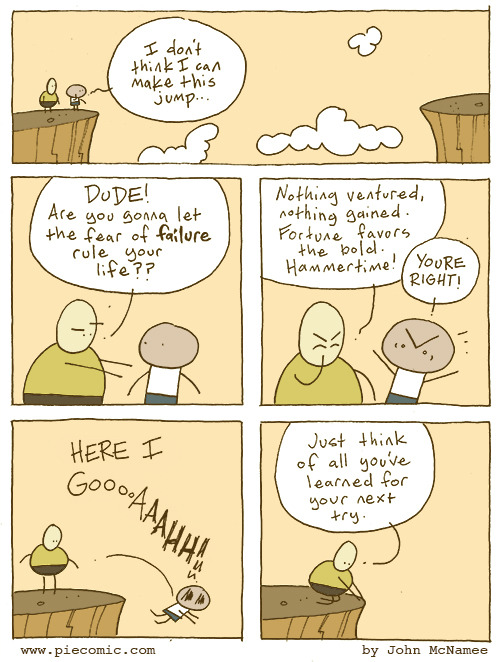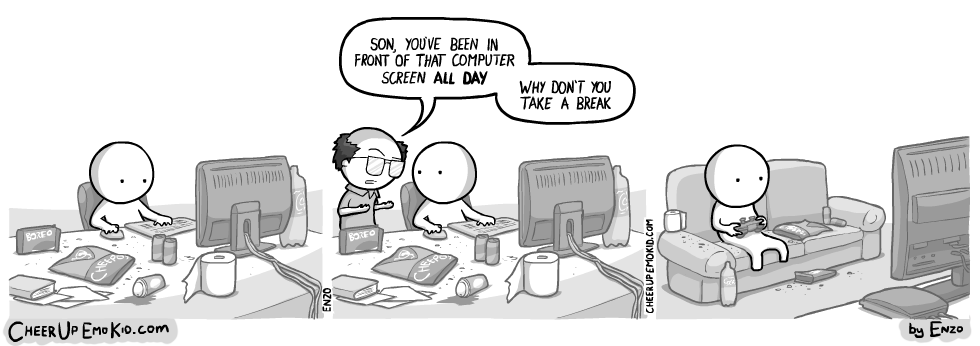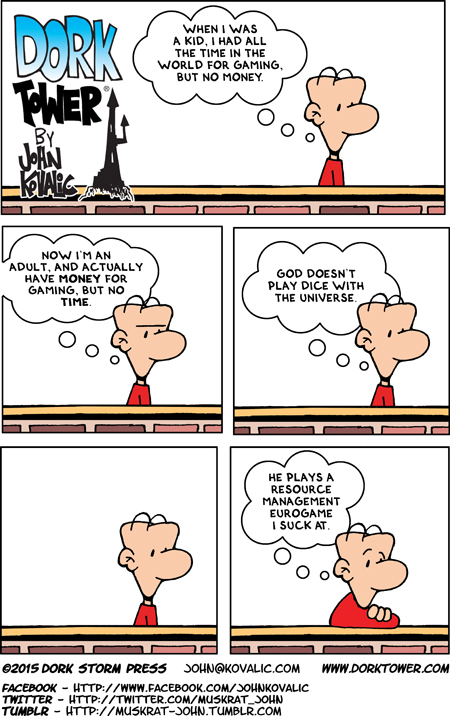
Dan Jones
Shared posts
Vicious Cycle
 For me, computers mean work. I have my laptop computer that I use for my 9-5, and I have my home computers that I use for freelance and other projects. If I'm in front of a screen to relax, it is either the television screen or a tablet. 99% of the time, when I am in front of a computer, I am working...or at the very least supposed to be working.
For me, computers mean work. I have my laptop computer that I use for my 9-5, and I have my home computers that I use for freelance and other projects. If I'm in front of a screen to relax, it is either the television screen or a tablet. 99% of the time, when I am in front of a computer, I am working...or at the very least supposed to be working.See more: Vicious Cycle
Microsoft Made Google Earth Before There Was Google Earth

A screengrab of Terraserver from 1999. Image: Tom Barclay
The Earth fit inside a 45-foot by 25-foot Compaq computer in an office building in suburban Seattle. As the East Coast woke up Monday mornings, it would roar to life.
"The temperature in the room would go up 5 to 6 degrees, things would start banging around,” Tom Barclay, the man tasked by Microsoft with putting the Earth inside a database, remembers. “You'd really marvel at it."
Terraserver could have, should have been a product that ensured Microsoft would remain the world’s most important internet company well into the 21st century. It was the first-ever publicly available interactive satellite map of the world. The world’s first-ever terabyte-sized database. In fact, it was the world’s largest database for several years, and that Compaq was—physically speaking—the world's largest computer. Terraserver was a functional and popular Google Earth predecessor that launched and worked well before Google even thought of the concept. It let you see your house, from space.
So why aren’t we all using Terraserver on our smartphones right now?
Probably for the same reason Microsoft barely put up a fight as Google outpaced it with search, email, browser, and just about every other consumer service. Microsoft, the corporation, didn't seem to care very little about the people who actually used Terraserver, and it didn’t care about the vast amount of data about consumers it was gleaning from how they used the service.
"It was something we did to show off our software could do this, but the company didn't care about the information," Barclay told me. "Google was an information company first. They saw the value of the information."
***

An internal prototype of Terraserver. The final version was more complex. Image: Tom Barclay
From the outset, the plan was to make a database. Microsoft didn't really care what information it contained, it just had to be big. The biggest in the world, something that would test the scalability of Microsoft's SQL database products.
"We had been asked to work on a very large database, to test this next-generation database product," Barclay told me. "It turns out that finding both an interesting and real terabyte of data that wasn't encumbered in some way, that we had the permission to [distribute legally], was a challenging problem."
According to a USA Today article from June 22, 1998, the initial plan with Terraserver was to list every single transaction in the history of the New York Stock Exchange online and make it searchable. But that was only a half terabyte of data. Microsoft needed something larger.
In 1997, the United States Geological Survey was in the process of uploading greyscale satellite photos and other aerial images from its archives onto the internet. Hedy Rossmeisl of the USGS met with famed Microsoft computer scientist Jim Gray, and they started brainstorming. Wouldn't it be interesting, and perhaps useful, they thought, if someone put searchable satellite images on the internet?

Terraserver as it looked on launch day. Image: Tom Barclay
The timing was more-or-less perfect. The Cold War was over, which allowed spy satellite imagery to be declassified, no one was worried about terrorism in a pre-9/11 world, and, well, the average person was beginning to get the internet.
"We had imagery from maybe half of the country done digitally and we had some capabilities to deliver them, but not in a fast, accessible way," Rossmeisl told me. "I thought getting the data on the web was really important, and I wanted to help make it happen."
The images, along with some from recently declassified Russian military photos, totaled just over 2.3 terabytes. The idea for Terraserver was born.
Gray put Barclay, who Rossmeisl called "the brains of the project" in charge, and he got to coding. He was a database guy—Terraserver was the first website he'd ever made, and it was the first project he'd ever tried that had anything to do with mapping, which proved to be quite a challenge. Barclay quickly ran into an age-old cartography problem.
"It turns out that 'round Earth, flat monitor' is an enormous pain in the neck," Barclay said.

Image: Strebe/Wikimedia Commons
He decided that using a standard Mercator map projection, which is what you see in the image above, wouldn’t work because it distorts the sizes of land masses as you move north and south on the projection. After trying a few things, Barclay came up with the idea of creating "mosaic" images that would be automatically generate based on where you're clicking on the map. Basically, the images given to Microsoft by USGS were stitched together but were then chopped into smaller images that could recenter themselves on cue.


A whitepaper published in 2000 explains how Barclay solved the projection issue. Images: Microsoft
"Originally, we hadn't done this. The very first demo we did, I chopped Bill Gates's house in half, which was not very good," he said. "We ended up with a progressive display that allowed people to drag and center the screen where they wanted it, and we computed zoomed out and zoomed in views."
These innovations proved to be revolutionary, and the "mosaic" strategy is now the "underpinning of Google Earth and Google Maps," Barclay said.
"I don't want to break my arm patting my back, but it's amazing how similar the current technologies are to what we did in 1998," he added. With the mapping problem solved, Terraserver went live, and the real fun began.
***

Image: Microsoft
I was 10 years old when Terraserver launched, and if I used it, I don't remember. Unfortunately, there's no way of using it today. Terraserver went offline in 2007, and Barclay spent most of his time working on Bing Maps. Microsoft periodically revived Terraserver from time to time even after 2007, but it's offline forever now. Barclay attempted to bring it back on a separate server for the purposes of this article, but said that the project proved too time consuming.
So while I don't remember Terraserver, it does seem like it made quite a splash when it launched. In addition to the USA Today article (more of a blurb, really), Terraserver also scored early stories from the New York Times and Newsweek, which worried about the system's potential privacy-invading potential (headline: "Surveillance in the sky").

Terraserver's initial specifications. Image: Microsoft
Microsoft held a launch event in New York City that Bill Gates attended. On the first day, 8 million people accessed the site, "millions more were rejected," according to a white paper published in 2000. By the end of the week, it was getting 30 million hits a day. Ultimately, the site settled down and served roughly 7 million people every day. It was more successful than anyone at Microsoft ever anticipated.
And that brings us to the dumbfounding thing about Terraserver, and about Microsoft. The reason, really, why I'm writing this article. In reading the white paper, it's astounding to see just how much information about general web behavior Microsoft was able to glean from the project, and it's astounding to see how it essentially blew it by looking at Terraserver as a novelty project rather than a potentially world-changing one.
Microsoft learned, maybe even before Google, that most search is local. If Terraserver didn't have images for people's hometowns, they got angry.

Image: Microsoft
"In the first year, I got 20,000 emails, and the vast majority of them said one of two things," Barclay said. "It was either 'I love Terraserver, I saw my house' or 'I hate Terraserver, I didn't see my house' We learned that 85 percent of all geospacial queries are local. They're looking for local search—they want to find whatever dry cleaner is around the corner, or where they could get fast food."
The entirety of the New York Times article about Terraserver's launch focuses on its utility as a database and all but ignores the possibility that it could serve as a method of collecting information about user habits.
"The project not only marks the creation of one whopper of a digital scrapbook, it also says something very big about Microsoft's effort to enter the database business, using as an opener a venture that can capture the public imagination,” the Times wrote. “Microsoft's strategy is to use Terraserver to prove that its software and operating system are suited to massive databases."

Image: Microsoft
It wasn't just that basic information, however. Microsoft also gleaned that "the internet is busiest on Mondays and Tuesdays" and that there was a "steady slide [in volume] from Wednesday through Friday." Saturdays and Sundays were half as busy as Mondays were. The 45-foot by 25-foot Compaq computer that stored the images would roar to life on Monday mornings as the East Coast woke up.
"The temperature in the room would go up 5 to 6 degrees around 9:30 AM on the East Coast, things would start banging around," Barclay said. "By 8 PM pacific time, you didn't have any traffic, because we didn't have any imagery in the Pacific Ocean."
None of this information was used by Microsoft, except as a way to determine when to perform maintenance on its servers or when to staff the server rooms. The only revenue Microsoft made directly off of Terraserver was on the sale of some of the satellite images, which you could buy and have mailed to your house for $9.95.
"In the science community, this technology took off, but as a business I could never get anyone at Microsoft to latch onto it," Barclay said. "There's definitely a little bit of frustration there."
***
It's easy to look at Terraserver as a missed opportunity for Microsoft to dominate the next era of computing, and it's hard to say why, exactly, the company decided to stop pouring resources into it. Current Microsoft representative declined to be interviewed for this article, and Jim Gray, Barclay's boss, was lost at sea in 2007.
It may be as simple as Barclay suggested: Microsoft didn't see itself as an information company, and the media was skeptical of its intentions had it decided to become one. In addition to the Newsweek article, the Chicago Sun Times ran an opinion piece in 2000 that questioned the company's motives with Terraserver.
"Some people are paranoid enough about Microsoft," Andy Ihnatko wrote in an article I accessed using LexisNexis. "How would these people react to discovering a Microsoft web server with an aerial photo of their house that's so good it shows the kiddie pool in the backyard?"
Other groups weren't as skittish. The most notable was Keyhole, which launched "Earth Viewer" in 2003 and used Terraserver as some of the underpinning of their technology. It sold the license to its Earth Viewer software for upwards of $600 annually to businesses and charged consumers $79 annually for a stripped down version of it. Google bought Keyhole in 2004, rebranded Earth Viewer as Google Earth in 2005 and, well, you know the rest of the story.
Tesla Coil Lighter

Tesla Coil Lighters are just one of your options if you're looking for a flameless, wind-proof lighter, but I think they're the cleverest looking. Simple, industrial exteriors with flip-tops that expose nifty arced coils serving as lighting mechanisms. To use, press the button and behold the electrical flow.
Tesla Coil Lighters are USB rechargeable, with each full charge lasting up to 1 week, or for 100 to 300 clicky flicks. A built-in safety feature prevents the mechanism from lighting when the lid is closed, even if some yay-hoo...or your butt...hits the button. Size is 3" x 1.75" x 0.5"; weight is 3 ounces.
God Doesn’t Play Dice with the Universe
 I fuckin' love Settlers of Catan! I will gladly challenge the big-guy-upstairs to race to get 10 victory points first, any day.
I fuckin' love Settlers of Catan! I will gladly challenge the big-guy-upstairs to race to get 10 victory points first, any day.See more: God Doesn’t Play Dice with the Universe
The Best Quotes About Reading
Are books and reading your passion? You aren’t alone! Below are some of our favorite quotes about reading.














Do you have a favorite quote about reading that you didn’t see above? Tell us in the comments!
Love Free eBooks? Sign up for our email and get free eBooks in your favorite genres every day!
The post The Best Quotes About Reading appeared first on Freebooksy.
Link's Female Counterpart 'Linkle' Confirmed for Hyrule Warriors Legends
Dan JonesLinkle? What a ridiculous name.
Link's Female Counterpart 'Linkle' Confirmed for Hyrule Warriors Legends
During today's Nintendo Direct, Nintendo officially announced Linkle, a female counterpart to Link, as a playable character for Hyrule Warriors Legends. Linkle was originally seen in concept art for Hyrule Warriors, but she didn't make it into the original release on Wii U. Linkle is an energetic young warrior that hails from a town full of Cuccos, and she wields dual-crossbows and has a spinning kick attack, much like Link?s spinning blade attack.
Here's some images of her from Nintendo of America and a video from GameXplain... Copslay anyone!? :D


LTE support allows Android Wear to free itself from your smartphone
With the retail launch of the LG Watch Urbane 2nd Edition LTE (wow, that’s a mouthful), Google has made Android Wear’s cellular support official. Keeping your Android Wear device connected no longer requires it to be shackled to your smartphone through WiFi or Bluetooth. If your LTE-capable smartwatch can’t locate your phone, it will automatically switch to LTE mode, allowing you to receive all your notification, use your apps and even make or receive calls.
Making phone calls from your wrist may sound like fun, but we’re honestly more excited about the idea of leaving our smartphone behind in certain situations while still being connected. As a runner, an LTE Android Wear watch would be the perfect companion, allowing me to track my runs, listen to music and even send and receive messages without having to strap my 5.2-inch phone to my arm.
How much extra are you willing to pay for an LTE-capable Android Wear smartwatch?
dressesandyarn: I wish I could bring my dogs to these but Elmo...





I wish I could bring my dogs to these but Elmo incites weird anger in other dogs and Ruby is the kid who would rather hang out at Grandma’s book club than be outside.
Conversations with and photos of everyday North Koreans


Harvard graduate student Christopher Carothers recently travelled to North Korea and, because he was an American white man who spoke Korean, he was able to talk with some everyday North Koreans. The conversations he had make for fascinating reading.
Our tour group visited a local high school in a city north of Pyongyang. The students were disappointed when none of us could name three female North Korean heroes from their revolutionary history.
I didn't mind their patriotism, and their curiosity was refreshing. But when asked how I liked Pyongyang, what could I say? Usually I just said polite things and was rewarded with beaming faces. But was I being fair to these young adults? Doesn't intercultural exchange require some basic honesty? I told Jong Ho that I liked Korean people and appreciated how clean and grand their capital was.
"However," I went on gingerly, "I have to admit that Pyongyang is a poor city and out of touch with the modern age. Even a poor provincial capital in China wouldn't be envious."
He took this in for a minute and looked thoughtful.
"It's okay," he said with a smile, "I'm very glad to meet you."
Carothers chatted with his tour guide about politics:
"Who will be the next leader of America?" she asked. I explained about our two parties and gave her my best guess.
"But even if the party switches from Democratic to what are they called, Republicans, relations with Korea are always so tense. Why? Why does a big country like America continue to provoke a small country like Korea? No one wants war. We always say we are ready for war, but no one wants war. I don't understand politics."
"What American provocations do you mean?" I asked, curious. "Didn't the Great Marshal Kim Jong Un threaten to turn Seoul into a sea of flames?"
"Well, he's responding to American military exercises. Always with the military exercises with the South."
"I think, uh, many countries do military exercises," I tried to explain. "Some are defensive. Honestly, many Asian countries including South Korea are concerned about China's growth and the North getting nuclear weapons and so have asked to work with the U.S."
"The U.S. has many nuclear weapons. Isn't it ... hypocritical?"
"Maybe. But should a country that can't provide electricity properly in its capital really have nuclear weapons?"
"I see," she said quietly.
The whole thing is well worth a read. Some of the photos accompanying the article were taken by Christian Petersen-Clausen, who also recently visited North Korea as a tourist. (The photos at the top of this post were taken by Petersen-Clausen as well.) Keegan Hamilton interviewed him about his photos at Vice.
Tags: Christian Petersen-Clausen Christopher Carothers Keegan Hamilton North Korea photography travelHe said one surprise from the trip was that many North Koreans seemed "pretty damn aware" of life in the outside world. He saw people in Pyongyang using smartphones, which are connected to the country's propaganda-filled "intranet" and blocked from calling foreign countries, but says he was told it was relatively easy for people to procure Chinese or South Korean SIM cards. Foreign media, smuggled into the country on USB sticks, was also reportedly common.
"They watch Chinese and South Korean soap operas, they see the cars, the fashion, everything," he said. "It's basically rubbed in their faces how poor they are, while at the same time they can't talk about that."
DC Comics Christmas Sweaters For Days
Dan JonesI need

Well, sweatshirts. Still…so festive.
Merchoid has unveiled the DC Comics Christmas sweatshirt lineup for 2015, and you can check out all of the new designs after the break…








Product Page ($44.99)
(via ComicBook.com)
Adorable Predators vs Prey Art
Adorable Predators vs Prey Art
Artist Alex Solis illustrated this adorable series of predatory animals devouring their prey in the cutest way possible. D'aww isn't nature just the sweetest! ♥ You can see the whole series here and here are a few words from the artist...
"An idea I?ve had for a while that I finally got around to starting up, doing a small series of adorable predators vs prey. #adorablecircleoflife"















Artist: Alex Solis - #adorablecircleoflife
Follow us on:
November 10 2015
Anime Alternative Recommendations
Anime Alternative Recommendations
A 9GAG user wrote these nine examples of how to move on to slightly better anime. Now of course this is just their personal opinion and recommendations, feel free to debate. What do you guys think and what are you favorite animes?

Source: 9GAG
Follow us on:
November 11 2015
GNU Emacs and XEmacs Schism
A little emacs history. Old article. GNU Emacs and XEmacs Schism
Hoodie Up As Arkham Batman Or Wonder Woman

Cooler weather means warmer clothes, but you can still let your DC geek flag fly with the Batman Arkham Suit-Up costume hoodie and a really cool Wonder Woman reversible women’s hoodie.
Take a closer look after the break.

Product Pages: Batman Arkham Suit-Up Costume Hoodie ($64.49) / Wonder Woman Reversible Women’s Hoodie ($53.49)
WordPress Now Powers 25 Percent of Websites
Dan JonesThis seems way too high.
Matt Mullenweg:
Sometimes it goes up and down through the course of a month, but it’s still a pretty fun milestone that we can now say about one in four websites are now powered by the scrappy open source underdog with its roots stretching all the way back to a single person in Corsica, France. We should be comfortably past 25% by the end of the year.
The big opportunity is still the 57% of websites that don’t use any identifiable CMS yet, and that’s where I think there is still a ton of growth for us (and I’m also rooting for all the other open source CMSes).
What a great success story WordPress is.
Full-Featured Offline Google Maps
Google Maps has a really cool mobile app for Android and iOS, but most of its features aren't available when you're offline. You can cache maps for small regions and that's pretty useful, but what if you want to cache the maps for an entire country or use navigation and driving directions when you're in a different country? The Here app offers this feature for free and now you can use it in Google Maps too.
"Now you can download an area of the world to your phone, and the next time you find there's no connectivity — whether it's a country road or an underground parking garage — Google Maps will continue to work seamlessly. Whereas before you could simply view an area of the map offline, now you can get turn-by-turn driving directions, search for specific destinations, and find useful information about places, like hours of operation, contact information or ratings," mentions Google.

"You can download an area by searching for a city, county or country, for instance, and tapping 'Download' on the resulting place sheet, or by going to 'Offline Areas' in the Google Maps menu and tapping on the + button. Once downloaded, Google Maps will move into offline mode automatically when it recognizes you're in a location with spotty service or no connectivity at all. When a connection is found, it will switch back online so you can easily access the full version of Maps, including live traffic conditions for your current route."

The new feature is gradually rolling out in the latest version of Google Maps for Android and it will soon be added to the iOS app. 6 years after launching turn-by-turn navigation, this feature works offline and Google Maps can finally replace paid navigation apps.




































